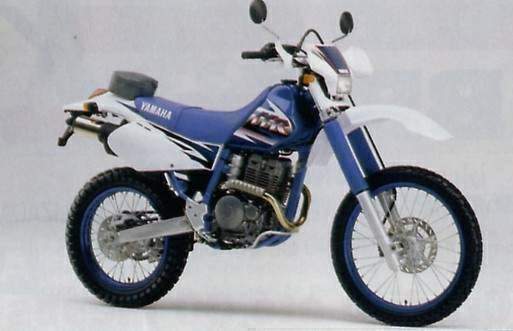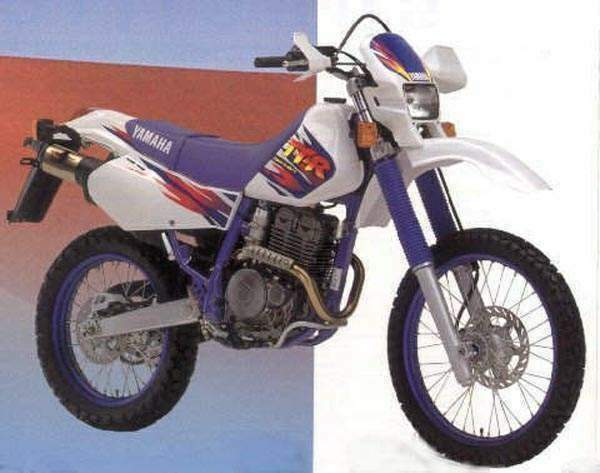Sometimes it's a good idea to
take a step back and ask yourself if the latest high-tech is
actually necessary to accomplish the goal at hand; the
Australians call the concept "appropriate technology" and it can
save you a lot of hassles.
The aim in this case was to build a tough, no-nonsense,
go-anywhere enduro bike that could master almost any terrain,
fast enough to compete at Regional if not National level but
without the hair-trigger responses that would scare rookies out
of the sport - and make it street legal.
Enter the Yamaha TT-R250. 15kW is more than enough for a
junior-class enduro bike so a sophisticated liquid-cooled engine
isn't called for
The aim was to build a tough, no-nonsense, go-anywhere enduro bike
The
TT-R250 has no vulnerable radiator and doesn't need a water pump
– instead it's got closely spaced cooling fins.
It doesn't need a finicky fuel-injection system, so it has a
neat 30mm Teikei slide carb – not even a CV diaphragm to split,
Cyril! – that can be stripped and cleaned out with a compressed
air nozzle if necessary.
It has a bulletproof, cable-operated wet clutch (who needs
hydraulics on a 15kW engine, I ask you) and a slick six-speed
transmission; no magic there.
But it also has a superbly efficient four-valve head with two
overhead camshafts and a self-tensioning cam chain for a broad
spread of power and lots of top-end punch, and CDI electronic
ignition that never needs setting.
It even has an electric starter – and if you've ever stalled an enduro bike in the middle of nowhere on a hot day you'll know what I mean by appropriate technology
It's
good enough to take you up to 118km/h on the flat 'n level (I
saw 132 with a bit of wind assistance, but that's cheating) and
if you can go that fast off-road, you're ready for a pukka race
bike, my china.
For the rest of us, the TT-R250 is more than fast enough to hold
its own in the traffic and even to cruise at 105km/h on the
freeway – returning less than five liters
/100km if ridden
sensibly – and grunty enough off the road to take you anywhere
you can walk.
The test bike had a very jerky throttle response and often
refused to idle; it was also extraordinarily cold-blooded, but I
suspect this was due to a blocked idle circuit in the carb of
the test bike rather than an inherent fault of the model – see
comments on carb, above, Yamaha.
This 15kW cocktail shaker is housed in a tubular-steel, double
cradle frame with a steel swing-arm fabricated from two oval
tubes and a few thick pressings.
It's much heavier than current fabricated-alloy chassis but
practically crash-proof – and if it does get bent any competent
small-town engineering shop can bash it straight without
compromising its metallic properties.
Plush suspension
But it has top-drawer, plush suspension with long, long travel,
from 43mm Kayaba forks adjustable for pre-load and compression
in front to a remote-reservoir monoshock from the same source
with an on-the-fly damping adjuster under the left side of the
saddle.
It keeps the bike controllable at silly speeds across open
fields and really comfortable when picking your way across rocky
terrain, so you can concentrate on where you're going rather
than on the bashing your butt is taking.
The suspension is a little soggy on the road but adequate within
the limits of the standard knobbly tyres; if you converted the
bike to a motard with 17" rims and sticky road tyres you'd soon
tie the suspension in knots – but that's not what this bike is
for.
Serious brakes
The only time the suspension isn't up to the call of duty is
under braking; the TT-R250 has serious disc brakes at each end
and, even with two fingers on the handlebar lever, it's possible
to induce enough front-end dive to make the front end misbehave
a little, especially on wet roads – did I mention that it rained
during the test?
The rear brake is also sharper than expected, great for inducing
big roosters on gravel roads but possibly more than's needed on
tar. Still, I'd rather have too much braking than too little.
The simple, plastic fuel tank and body panels are perhaps a bit
more solid than they need to be, but if the state of the
hard-used test bike is anything to go by that's not such a bad
thing; even after more than 13 000km of abuse all it needed was
the scratches buffed out and a new set of self-adhesive graphics
and it'd look good as new.
Basic instruments
The styling is modern, with the tank enclosing the top of the
engine as if to protect a non-existent radiator and not much
rise to the long, narrow saddle, but the latter isn't quite as
plank-like as it looks and the bike is surprisingly comfortable
for a couple of hours at a time.
The instrumentation is basic in the extreme; just a small,
quarter-quadrant speedo, trip meter and three idiot lights – the
bottom left panel is a blank – but, once again, that's what's
needed on this bike.
If the TT-R250 250 looks strangely familiar, it should; Yamaha
has sold a number of them to the SAPS, which uses them to chase
the bad guys all over our inner cities and in other scenarios
where normal police vehicles are at a disadvantage.
And if the cops, who use the bikes as the tools of their trade
rather than as weekend toys, can't break them - neither will
you.
Source
Motoring.co.za


